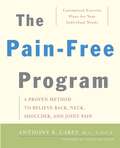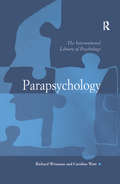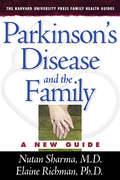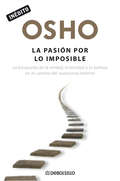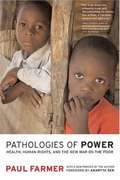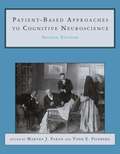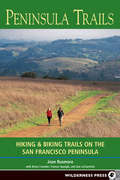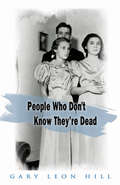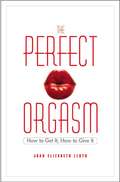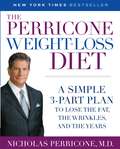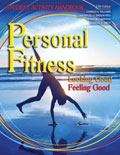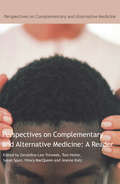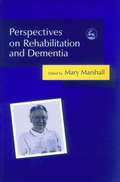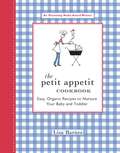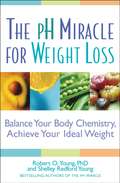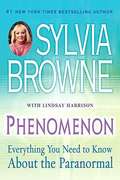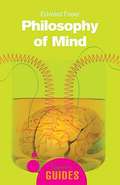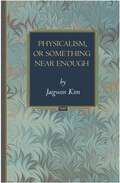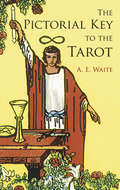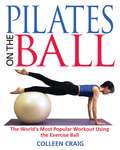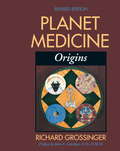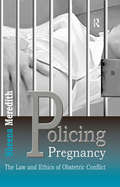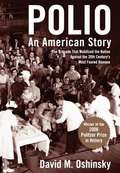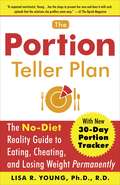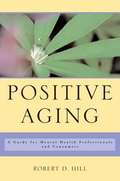- Table View
- List View
The Pain-Free Program
by Carey Anthony B."Anthony Carey hits the bull's-eye! Striving for a pain-free lifestyle is a goal we all want to achieve, and this book is a powerful tool to help you attain it. " --Bradford Stiles, M. D. , Medical Director of California Sports & Industrial Medical Center "Anthony Carey's unique approach to promote the proper function of the whole body in order to support and heal the problematic area delivered the results that made me a lifetime believer. I continue to utilize Anthony's techniques to train and heal my body every day. I only wish I would have found his program earlier in my career. " --Erik Kramer, former NFL Quarterback An innovative, therapeutic exercise program to stop the pain for good If you're one of the millions who suffer from chronic back, neck, shoulder, and joint pain, all you can think about is relief. Now, exercise physiologist Anthony Carey presents a breakthrough whole-body approach to pain relief that will help your body function and heal the way it was designed to. The Pain-Free Program shows you how to assess and treat the underlying cause of your pain rather than trying to simply fix your symptom area alone. Carey provides an individualized program for your specific body form, complete with customized exercise routines. This prescriptive guide: * Addresses the full range of pain sources, outlining the typical "hot zones" where pain tends to occur and why * Presents customized programs based on 6 major body forms identified by the author * Features over 100 photographs and illustrations that demonstrate appropriate exercise positions, techniques, and modifications * Reveals how you can prevent future injuries The Pain-Free Program gives you the tools you need to get rid of the pain for good--and stay healthy for the rest of your life.
Parapsychology: A Beginner's Guide (The International Library of Psychology)
by Caroline WattMany people believe that they have experienced paranormal phenomena and others claim to possess psychic abilities. For the past hundred years or so, researchers have undertaken systematic and scientific work into these alleged experiences and abilities. This collection of articles provides readers with a general sense of the methods used in this research, the findings that have been obtained and the controversies generated by this work. They cover a wide range of issues, including the psychology of paranormal belief, investigations into ghosts and hauntings, laboratory research into extra-sensory perception and psychokinesis, and controlled tests of psychics and mediums. An introductory essay sets each of the selected papers in context and provides additional references for those wishing to delve deeper into the issues surrounding each of the areas covered.
Parkinson's Disease and the Family: A New Guide (The Harvard University Press Family Health Guides #2)
by Nutan Sharma Elaine RichmanToo often, with Parkinson's disease, a loved one serves as medical interpreter, patient advocate, and caregiver. Sharma and Richman draw on the latest research and clinical practice techniques to offer valuable suggestions for managing patient care and, perhaps more important, for healing the family unit.
Pasión por lo imposible
by Osho OshoConsiderado un gurú del siglo XX, las enseñanzas de Osho (1931-1990) han sido recogidas a lo largo de una extensa obra. Este volumen es un compendio de todas las técnicas de Osho -debidamente sistematizadas- para potenciar el crecimiento personal y para hallar el camino que conduce a la verdad.
Pathologies of Power: Health, Human Rights, and the New War on the Poor
by Paul FarmerPathologies of Power uses harrowing stories of life--and death--in extreme situations to interrogate our understanding of human rights. Paul Farmer, a physician and anthropologist with twenty years of experience working in Haiti, Peru, and Russia, argues that promoting the social and economic rights of the world's poor is the most important human rights struggle of our times. With passionate eyewitness accounts from the prisons of Russia and the beleaguered villages of Haiti and Chiapas, this book links the lived experiences of individual victims to a broader analysis of structural violence. Farmer challenges conventional thinking within human rights circles and exposes the relationships between political and economic injustice, on one hand, and the suffering and illness of the powerless, on the other. Farmer shows that the same social forces that give rise to epidemic diseases such as HIV and tuberculosis also sculpt risk for human rights violations. He illustrates the ways that racism and gender inequality in the United States are embodied as disease and death. Yet this book is far from a hopeless inventory of abuse. Farmer's disturbing examples are linked to a guarded optimism that new medical and social technologies will develop in tandem with a more informed sense of social justice. Otherwise, he concludes, we will be guilty of managing social inequality rather than addressing structural violence. Farmer's urgent plea to think about human rights in the context of global public health and to consider critical issues of quality and access for the world's poor should be of fundamental concern to a world characterized by the bizarre proximity of surfeit and suffering.
Patient-based Approaches to Cognitive Neuroscience (2nd edition)
by Martha J. Farah Todd E. FeinbergIn addition to the updated coverage of perception, attention, memory, language, executive function, and development, the new edition includes expanded material on functional neuroimaging of normal subjects and of neurological patients, electrophysiological methods including TMS, and the genetics of neurocognitive disorders.
Peninsula Trails
by Sue Latourrette Jean Rusmore Betsy Crowder Frances SpangleChoose from more than 150 trips on over 500 miles of trails with this comprehensive guide to every park and preserve on the San Francisco Peninsula. From Fort Funston and San Bruno Mountain south to Saratoga Gap, and from the Bay west to the Pacific Ocean, the peninsula offers something for everyone. This edition includes 18 new trips covering newly acquired public lands. Also includes maps and a trips-by-theme appendix.
People Who Don't Know They're Dead
by Gary Leon HillIn People Who Don't Know They're Dead, Gary Leon Hill tells a family story of how his Uncle Wally and Aunt Ruth, Wally's sister, came to counsel dead spirits who took up residence in bodies that didn?t belong to them. And in the telling, Hill elucidates much of what we know, or think we know, about life, death, consciousness, and the meaning of the universe. When people die by accident, in violence, or maybe they're drunk, stoned, or angry, they get freeze-framed. Even if they die naturally but have no clue what to expect, they might not notice they're dead. It's frustrating to see and not be seen. It's frustrating not to know what you're supposed to do next. It's especially frustrating to be in someone else's body and think it's your own. That's if you're dead. If you're alive and that spirit has attached itself to you, well that's a whole other set of frustrations. Wally Johnston, a behavioral psychologist, first started working with a medium in the 70s to help spirits move on to the next stage. Some years after that, Ruth Johnston, an academic psychiatric nurse, who'd become interested in new consciousness and alternative healing, began working with Wally to clear spirits who weren't moving on. These hitchhikers had attached themselves to the auras of living relatives or strangers in an attempt to hold on to a physical existence they no longer need. Through her pendulum, Ruth obtains permission from the higher self of both hitchhiker and host to work with them. Then Wally speaks with them, gently but firmly, to make sure they know they are no longer welcome to inhabit the bodies and wreak havoc on the lives of the living. Hill has woven this fascinating story with the history and theory of what happens at death, with particular emphasis on the last 40 years and the work of such groundbreaking thinkers as Elmer Green, Raymond Moody, William James, Aldous Huxley, Edith Fiore, Martha Rogers, Mark Macy, Elisabeth Kubler-Ross, Bruce Lipton, and a host of others, whose work helps inform our idea of what it is to live and to die. As it turns out, our best defense against hitchhikers is to live consciously. And our best chance of doing that is by paying attention and staying open to possibilities.
The Perfect Orgasm
by Joan Elizabeth LloydThe perfect orgasm isn't born. It's made-patiently, attentively, lovingly. Now Joan Elizabeth Lloyd, one of America's most celebrated sex experts and the author of Nice Couples Do, If It Feels Good, Come Play with Me, and 52 Saturday Nights, reveals intimate secrets available in no other guide. Step by step and drawing on the experiences of men and women just like you, you'll learn how to bring your partner to the peak of pleasure...and how to help him or her do the same for you.
The Perricone Weight-Loss Diet: A Simple 3-Part Plan to Lose the Fat, the Wrinkles, and the Years
by Nicholas PerriconeFrom #1 New York Times bestselling author Nicholas Perricone– respected physician, award-winning research scientist, and trusted expert on health and beauty–comes the biggest breakthrough in weight loss since Atkins. Millions of women and men have restored youthful radiance, smoothness, and suppleness to their skin through Dr. Nicholas Perricone’s advice, care, and transformative eating plan–and all with the welcome yet unexpected benefit of losing excess weight along with the wrinkles! Building on this discovery, Dr. Perricone breaks new ground with his trademark anti-inflammatory program based on the foods, supplements, and lifestyle changes with the proven ability to accelerate fat loss by increasing metabolism and building and maintaining muscle mass. Consider this staggering fact: As we age, we can expect to gain ten pounds of fat and lose five pounds of muscle each decade. In three easy steps, Dr. Perricone shows how to fight this weight gain and rebuild muscle mass, and avoid the haggard, aging, and drawn appearance that results from other weight-loss programs. Inside The Perricone Weight-Loss Diet discover • the rejuvenating and slimming secrets of the anti-inflammatory diet • which foods, supplements, and lifestyle changes enable us to lose fat while maintaining muscle • how to control hormones such as insulin and cortisol to lose weight • how to maintain youthful, firm, and radiantly toned skin on the face and body during weight loss As an added bonus, as you follow Dr. Perricone’s program you’ll sleep better, have more energy and less stress, and experience greater mental clarity without the food cravings. Lose the weight, the wrinkles, and the years! From the Hardcover edition.
Personal Fitness: Looking Good, Feeling Good (Fifth Edition)
by Charles S. WilliamsDesigned to promote self awareness; the relationship between physical health and fitness and the way you perceive yourself; with the end goal of establishing a total lifestyle change
Perspectives on Complementary and Alternative Medicine: A Reader
by Jeanne Katz Tom Heller Geraldine Lee-Treweek Susan Spurr Hilary MacQueenComplementary and alternative medicine (CAM) is an emerging and increasingly popular group of treatments, therapies and philosophies of health and wellbeing. It is a fascinating and fast-changing area of social life, which also poses an interesting challenge to current healthcare delivery and policy making. This reader presents a lively and engaging collection of classic, controversial and new readings on CAM and covers issues including: changes in the way CAM is developing and being delivered holism and what this concept means to CAM practice changes in consumption and the health consumer that have lead to increased interest in CAM the safety and effectiveness of CAM treatments how integration is being achieved in contemporary society. The text provides insight into many of the current and complex issues surrounding CAM, and will appeal to everyone who is concerned with, or who has an interest in, complementary and alternative healthcare. The book will be essential reading for students of CAM, health studies, nursing, medicine and allied health subjects, as well as medical sociology and modern health policy.
Perspectives on Rehabilitation and Dementia
by Faith Gibson Mary Marshall Suzanne Cahill Linda Clare'The volume has ambitious scope and covers almost all potential supports and services. Most of the chapters have been written by professionals who work with people with dementia and their families, and most are British social workers and professionals allied-to-medicine (occupational therapy, physiotherapy and speech and language therapy).' - Ageing and Society 'Marshall, in her introduction, states that the aim of the book is to strengthen the link between rehabilitation and dementia and to encourage the understanding that people with dementia do benefit from rehabilitation and treatment. The book clearly meets this aim with the contributors offering convincing arguments for the conceptualisation of dementia care as rehabilitation and the potential for improvements in symptoms and in quality of life for people with dementia... The book is accessible, easy to read, informative and provides practical information and new ideas useful for practitioners, services providers, commissioners and policy makers.' - Social Policy 'This book has much to offer a range of professionals and those teaching them at post-qualifying levels.' - Journal of Interprofessional Care 'The chapters give us a real and honest appraisal of the pains and possibilities of dementia. And David Jolley ends his chapter with what could be seen as a surprising statement that "Life with dementia is worth Living". His ideas sum up the tone of the book which asserts that people with dementia still have much to give but need help in order to maintain health, safety and dignity, and offers various practical therapeutic models that have been worked out in different settings... throughout the book we are encouraged to keep the person with dementia at the centre of care and to see them as a unique individual with a disability who needs help.' - Perspectives on Rehabilitation and Dementia 'Service planners could gain from dipping in to this collection and testing the extent to which their current plans reflect the thinking shared by the authors. The importance of team working is stated throughout, and in an era of partnership working this provides yet another useful policy book on which to hang revised plans' - Community Care 'Contributions from people with dementia and their families provide the central core of the text and anchor it firmly in reality. There is a unanimously positive approach to rehabilitation. Many of the authors focus on self esteem and confidence with many references to the need of teamwork. They also share the positive view of people with dementia, which concentrates on personhood focussing upon the whole person, drawing upon their strengths as well as taking into account declining abilities in some areas. This book is strongly recommended for health care professions, particularly nursing courses.' - London Centre for Dementia Care News 'The book explores the positive outcomes for people with dementia in terms of quality of life and self-esteem, especially if rehabilitation is seen as a positive philosophy of practice as well as a set of skills and approaches. It includes many different perspectives from a diverse group of professionals, carers and practitioners, and people with dementia themselves.' - Working with Older People Perspectives on Rehabilitation and Dementia offers new insights into the application of a well-established approach and set of skills to a group of people who have traditionally been thought not to benefit from them. Indeed people with dementia have missed out on physical and psychological rehabilitation very substantially. This book demonstrates that rehabilitation has positive outcomes for people with dementia in terms of quality of life and self-esteem, especially if rehabilitation is seen as a positive philosophy of practice as well as a set of skills and approaches. The perspectives in this book are those of a very diverse group of professionals, carers, and people with dementia themselves. Professional backgrounds and the settings in which they work are diverse and include both academics and prac...
The Petit Appetit Cookbook: Easy, Organic Recipes to Nurture Your Baby and Toddler
by Lisa BarnesFresh, wholesome meals that give little mouths something to smile about... In The Petit Appetit Cookbook, mother and professional cook Lisa Barnes offers a healthy all-organic alternative to commercially processed, preservative-filled foods to help create delicious menus, nurture adventurous palates, and begin a lifetime of positive eating habits for children. Includes: 150+ easy, fast, child-tested recipes for ages 4 months to 4 years - Mealtime solutions for even the most finicky eaters - Nutritional information for each recipe - Time-saving cooking techniques - The right age and stage appropriate food choices - How and when to introduce solids to baby's diet - Adapting family recipes for young children - Recognizing signs of food allergies and intolerances.
The pH Miracle for Weight Loss: Balance Your Body Chemistry, Achieve Your Ideal Weight (pH Miracle)
by Robert O. Young Shelley Redford YoungLet's start with simple math. How many excess pounds do you need to shed to achieve your ideal, healthy weight-10, 30, 100? Whatever your answer, multiply it by two. You now have the Maximum number of days it will take you to reach your goal, if you follow... Despite what you may believe, weight loss is not about fat grams, cholesterol, carbs, or calories. It's all about acid. According to Dr. Robert Young, renowned microbiologist and nutritionist, reaching your ideal weight is simply a matter of maintaining the delicate pH balance of the blood. In this latest entry in the successful pH Miracle series, Dr. Young and his wife, chef Shelley Redford Young, offer a simple 7-step lifestyle program to balance your body chemistry, change your shape, and slim down to your ideal body weight-naturally and permanently. Best of all, you'll be able to eliminate unnecessary fat cells forever. From the science behind the plan to the dietary do's and don'ts (along with recipes), a detailed exercise plan, and dozens of dramatic real-life before-and-after photos, this program lays the groundwork for long-term success. Discover: * How drinking the right water can help you lose weight * Why you should ignore the fat phobes and keep plenty of healthy oils in your diet * Which common foods make your body more alkaline-and which ones make it more acidic * How exercise can actually make you fat-unless you do it the right way * The benefits of having your blood analyzed at the microscopic level * How you can build lean muscle and maintain healthy bones without loading up on proteins and dairy ... and much more!
Phenomenon: Everything You Need to Know About the Paranormal
by Sylvia Browne Lindsay HarrisonIn this compelling new book, bestselling author Sylvia Browne offers her most comprehensive guide to the afterlife. Phenomenon is a fascinating compendium of all things on the Other Side that influence our life here on Earth. Sylvia Browne provides evocative stories and powerful explanations to help make life on the Other Side real for all of us. In Phenomenon, she provides reassuring answers to questions such as: Atlantis - Where did it go and when will it return? Clairvoyance - How do you know if you have the gift? Deja vu - Are past lives the answer to this strange phenomenon? Ghosts - What are they? Miracles - Can they happen every day? Reincarnation - Have we lived before? Sorcery - Is there something we should fear? Zombies - Are they only in horror movies? An easy-to-use reference full of hope and guidance, Phenomenon is sure to have wide appeal among Browne's loyal fans and anyone in search of signs of the paranormal.
Philosophy of Mind: A Beginner's Guide (Beginner's Guides)
by Edward FeserIn this lively and entertaining introduction to the philospohy of the mind, Edward Feser explores the questions central to the discipline.
Physicalism, or Something Near Enough (Princeton Monographs in Philosophy #19)
by Jaegwon KimContemporary discussions in philosophy of mind have largely been shaped by physicalism, the doctrine that all phenomena are ultimately physical. Here, Jaegwon Kim presents the most comprehensive and systematic presentation yet of his influential ideas on the mind-body problem. He seeks to determine, after half a century of debate: What kind of (or "how much") physicalism can we lay claim to? He begins by laying out mental causation and consciousness as the two principal challenges to contemporary physicalism. How can minds exercise their causal powers in a physical world? Is a physicalist account of consciousness possible? The book's starting point is the "supervenience" argument (sometimes called the "exclusion" argument), which Kim reformulates in an extended defense. This argument shows that the contemporary physicalist faces a stark choice between reductionism (the idea that mental phenomena are physically reducible) and epiphenomenalism (the view that mental phenomena are causally impotent). Along the way, Kim presents a novel argument showing that Cartesian substance dualism offers no help with mental causation. Mind-body reduction, therefore, is required to save mental causation. But are minds physically reducible? Kim argues that all but one type of mental phenomena are reducible, including intentional mental phenomena, such as beliefs and desires. The apparent exceptions are the intrinsic, felt qualities of conscious experiences ("qualia"). Kim argues, however, that certain relational properties of qualia, in particular their similarities and differences, are behaviorally manifest and hence in principle reducible, and that it is these relational properties of qualia that are central to their cognitive roles. The causal efficacy of qualia, therefore, is not entirely lost. According to Kim, then, while physicalism is not the whole truth, it is the truth near enough.
The Pictorial Key to the Tarot (Dover Occult Ser.)
by A. E. WaiteLong used in telling fortunes and popular today among New Agers, Tarot cards are regarded by many as "the training wheels" on the bicycle of psychic development. Centuries of scientific progress have not diminished the irresistible attraction of gazing at picture cards to see the future and determine one's fate. This book by Arthur Edward Waite, the designer of the most widely known Tarot deck and distinguished scholar of the Kabbalah, is the essential Tarot reference. The pictorial key contains a detailed description of each card in the celebrated 78-card Rider-Waite Tarot deck, along with regular and reversed meanings. Contents describe symbols and secret tradition; the four suits of Tarot, including wands, cups, swords, and pentacles; the recurrence of cards in dealing; an ancient Celtic method of divination; as well as wonderful illustrations of Tarot cards.While the perfect complement to old-style fortune telling, The Pictorial Key to the Tarot also serves to make the Tarot entirely accessible to modern-day readers. It is also the classic guide to the Rider-Waite deck and to Tarot symbolism in general.
Pilates on the Ball: The World's Most Popular Workout Using the Exercise Ball
by Colleen CraigA unique and exciting synthesis of two highly acclaimed fitness techniques: Pilates Method and the Swiss exercise ball.• Non-impact Pilates exercises on the ball can be adapted for all levels of ability, from fitness trainers and weekend athletes to those healing from injury or chronic back pain. • Shows how to practice Pilates techniques without expensive equipment.• Profusely illustrated with black-and-white photographs for maximal learning.The Pilates Method of body conditioning is a highly effective workout technique that strengthens the body while engaging the mind. Developed in the early twentieth century by accomplished boxer and gymnast Joseph Pilates, the Pilates Method aligns the body; builds long, lean muscles; and develops core abdominal strength. Many lifestyle and fitness magazines have named Pilates the hottest workout of the decade. In a first-of-its-kind fusion, Pilates on the Ball merges the principles and exercises of the highly effective Pilates Method of body conditioning with the unique functions of the exercise ball, used by Olympic coaches, dancers, and athletes to fine-tune body awareness and enhance physical performance. The ball magnifies the benefits of the carefully developed and refined Pilates Method. Because maintaining balance on the ball recruits the deep, stabilizing muscles of the spine, the postural muscles are strengthened. The ball intensifies athletic performance by increasing resistance and heightening awareness of how the body moves in space. Chapters detail the Pilates principles step by step, with successive movements to challenge all levels of ability and "watch points" for careful evaluation of your form. Intense enough to engage seasoned athletes yet accessible enough to use as an everyday exercise routine or to alleviate chronic pain, Pilates on the Ball builds strong bodies and engaged minds.
Planet Medicine: Origins, Revised Edition
by John E. Upledger Richard GrossingerPlanet Medicine is a major work by an anthropologist who looks at medicine in a broad context. In this edition, additions to this classic text include a section on Reiki, a comparison of types of palpation used in healing, updates on craniosacral therapy, and a means of understanding how different alternative medicines actually work. Illustrated throughout, this is the standard on the history, philosophy, and anthropology of this subject.
Policing Pregnancy: The Law and Ethics of Obstetric Conflict
by Sheena MeredithAre pregnant women entitled to the same rights of self-determination and bodily integrity as other adults? This is the fundamental question underlying recent high-profile legal interventions in situations when pregnant women and healthcare staff do not agree on management options or appropriate behaviour. Courts on both sides of the Atlantic have sometimes answered that they are not, and the law has at times been manipulated to enforce compliance with medical recommendations. This is the first book of its kind to offer a comprehensive assessment of healthcare law as applied to the unique situation of pregnancy. Drawing on case material from both the UK and the USA, it describes the trend towards 'policing pregnancy' and explores the emergence of the concept of 'maternal-foetal conflict' - and why, in the author's view, this would be more appropriately labelled 'obstetric conflict'. Suggestions are made for alternative approaches that better safeguard the overall well-being of pregnant women and their future children.
Polio: An American Story
by David M. OshinskyAll who lived in the early 1950s remember the fear of polio and the elation felt when a successful vaccine was found. Now David Oshinsky tells the gripping story of the polio terror and of the intense effort to find a cure, from the March of Dimes to the discovery of the Salk and Sabin vaccines - and beyond. Here is a remarkable portrait of America in the early 1950s, using the widespread panic over polio to shed light on our national obsessions and fears. Drawing on newly available papers of Jonas Salk, Albert Sabin and other key players, Oshinsky paints a suspenseful portrait of the race for the cure, weaving a dramatic tale centered on the furious rivalry between Salk and Sabin. Indeed, the competition was marked by a deep-seated ill will among the researchers that remained with them until their deaths. The author also tells the story of Isabel Morgan, perhaps the most talented of all polio researchers, who might have beaten Salk to the prize if she had not retired to raise a family. As backdrop to this feverish research, Oshinsky offers an insightful look at the National Foundation for Infantile Paralysis, which was founded in the 1930s by FDR and Basil O'Connor. The National Foundation revolutionized fundraising and the perception of disease in America, using "poster children" and the famous March of Dimes to raise hundreds of millions of dollars from a vast army of contributors (instead of a few well-heeled benefactors), creating the largest researchand rehabilitation network in the history of medicine. The polio experience also revolutionized the way in which the government licensed and tested new drugs before allowing them on the market, and the way in which the legal system dealt with manufacturers' liability for unsafe products. Finally, and perhaps most tellingly, Oshinsky reveals that polio was never the raging epidemic portrayed by the media, but in truth a relatively uncommon disease. But in baby-booming America - increasingly suburban, family-oriented, and hygiene-obsessed - the specter of polio, like the specter of the atomic bomb, soon became a cloud of terror over daily life. Both a gripping scientific suspense story and a provocative social and cultural history, Polio opens a fresh window onto postwar America.<P><P> Pulitzer Prize Winner
The Portion Teller Plan: The No Diet Reality Guide to Eating, Cheating, and Losing Weight Permanently
by Lisa R. YoungThe Portion Teller Plan is a sensible eating guide and the end of diet deprivation. No forbidden foods, no calorie counting. Welcome to diet liberation.Would you ever consider going to the kitchen in the morning and grabbing five slices of bread for breakfast? No? Just one bagel is more like it, right? Well, your morning bagel is equivalent to eating five slices of bread. Your steak at dinner is equal to the protein in eighteen eggs. And that huge bowl of pasta you had at lunch is anybody's guess. Nobody likes to cut back but the cold hard facts are in: Portion sizes have steadily increased over the past thirty years and our collective waistlines are ballooning right along with them. You may need to eat a little less if you want to lose weight, but with The Portion Teller Plan you can eat all of your favorite foods. Nutrition and portion size expert Dr. Lisa Young presents an individualized guide to eating according to your portion personality and food preferences. You'll learn a simple system of visuals-a deck of cards, a baseball, your own hand-to help gauge portion size. You'll be able to eat out, eat in, cheat, and eat on the road without ever being a portion victim again.
Positive Aging: A Guide for Mental Health Professionals and Consumers
by Robert D. Hill<p>Retirement, senility, disability, and death were all notions previously associated with growing old. <p>Today, with the average life span of men and women in the United States exceeding 76 years, the words successful, optimal, and positive dominate the lexicon of scientists and, increasingly, the general public. We not only plan to live longer, but expect to enjoy a superior standard of physical and emotional health for longer than any previous generation. Leading an active and purposeful life no longer stops at the outdated 65-year mark of retirement, but continues well into what was once termed "old age." With these changing attitudes comes the need for new conceptualizations of what it means to grow old. <p>In a groundbreaking book, Robert Hill, a psychologist, professor, and leading researcher in geriatric care, rethinks the traditional ideas we have of aging by offering us a new framework from which to understand the nature of growing old. Positive Aging offers a more innovative model of old age that focuses on achieving and fostering a positive mindset. In doing so, Hill not only explores the social and psychological trends of aging in the 21st century, but offers an illuminating examination of how advances in the science of gerontology influence the phenomenology of growing old. <p>Written for all those concerned about their own course of aging as well as the practitioner who provides mental health services to older adults, Positive Aging begins with a review of the term "aging" itself, its history and its changing meaning. Hill then delves into the many lifestyle choices we can make to improve our happiness as we grow older. Traditional theories of adult development and how Positive Aging plays into them are examined; successful, normal, impaired, and diseased trajectories of age-related decline are defined and explored; and useful strategies are provided for coping with common old-age issues—including cognitive deficits, depression, anxiety, and psychological barriers to happiness. Hill also covers important late-life concerns such as the role Positive Aging plays in physical disability, caregiving, grief, bereavement, death, and spirituality and meaning-based counseling. Along the way, poignant case studies help elucidate and contextualize the arguments, and keep the discussion rooted in very tangible, human terms. <p>Ushering in an era of new understanding of what it means to grow older, Positive Aging is an enlightening guidebook for consumers navigating such uncertain, and often worrisome terrain, as well as an invaluable resource for clinicians working with this growing population. By combining a novel approach to human aging in the contemporary world with specific suggestions and ideas to optimize that process, this book promises to help all of us cope with the vicissitudes of growing older to continue to get the most out of living.</p>
